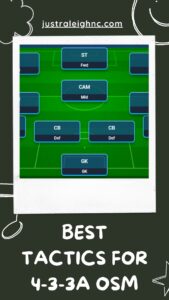In the realm of online football management simulations, One Soccer Manager (OSM) stands out as a platform where tactical prowess often determines success.
Among the myriad formations available, the 4-3-3B formation holds a unique position, offering a balance of offensive firepower and defensive solidity.

However, mastering this formation requires a deep understanding of its intricacies and the ability to tailor tactics to suit your team’s strengths. In this comprehensive guide, we delve into the best tactics for 4-3-3B in OSM, equipping you with the knowledge needed to dominate the virtual pitch.
Best Online Soccer Manager Formation for 4-3-3B (Tactics)
Formation: 4-3-3B
Style of play: Wing Play
Forwards: Attack only
Midfielders: Stay in position
Defenders: Defend deep
Offside trap: Yes
Marking: Zonal marking
Tackling: Normal
Pressing: 68%
Style: 75%
Tempo: 68%
Understanding the 4-3-3B Formation
- The 4-3-3B formation consists of four defenders, three midfielders, and three forwards.
- It emphasizes width, with wingers playing a crucial role in both attacking and defensive phases.
- The midfield trio provides stability, controlling the tempo of the game and supporting both defensive and offensive actions.
- The lone striker upfront requires support from the wingers and midfielders to create scoring opportunities.
Player Roles and Selection
- Goalkeeper: Opt for a reliable shot-stopper with good reflexes and distribution skills.
- Defenders: Center-backs should excel in aerial duels and possess strong tackling abilities. Full-backs need pace and stamina to contribute in both defense and attack.
- Midfielders: The central midfielder should be a creative playmaker capable of dictating play. Defensive midfielders require strong tackling and interception skills, while the attacking midfielder should possess vision and passing ability.
- Forwards: Wingers need pace, dribbling, and crossing skills to provide width and supply crosses to the striker. The lone striker must be adept at finishing chances and holding up play.
Offensive Tactics:
- Exploit Width: Instruct wingers to stay wide and provide crosses into the box. Utilize overlapping runs from full-backs to stretch the opposition’s defense.
- Quick Counterattacks: With pacey wingers and a lone striker, exploit counterattacking opportunities by playing direct passes behind the defense.
- Overload the Box: Encourage midfielders to make late runs into the box to support the striker during the attacking phases.
- Dynamic Movement: Rotate the front three to confuse defenders and create space for goal-scoring opportunities.
Defensive Tactics:
- Compact Midfield: Maintain a compact midfield to limit the opponent’s passing options and prevent penetration through the center.
- Pressing from the Front: Instruct forwards and midfielders to press high up the pitch to force turnovers and disrupt the opponent’s build-up play.
- Solid Defensive Shape: Ensure defenders maintain their positions and avoid being dragged out of position. Use the offside trap cautiously to catch opponents off guard.
- Counterpressing: Immediately press the opponent after losing possession to regain the ball quickly and prevent counterattacks.
Set-Piece Strategies
- Corners: Position tall players in the box for attacking corners and aim for their heads with inswinging deliveries.
- Free Kicks: Assign a designated free-kick taker with good accuracy and curve. Opt for direct shots on goal or look for opportunities to play short and create space for a shot.
- Penalty Kicks: Designate a reliable penalty taker and encourage composure under pressure. Practice penalties regularly to improve conversion rates.
In-Game Adjustments:
- Analyze Opponent’s Weaknesses: Adapt tactics based on the opponent’s formation and playing style. Exploit vulnerabilities while minimizing your own weaknesses.
- Substitutions: Use substitutions strategically to inject fresh legs or tactical changes based on the flow of the game.
- Tactical Flexibility: Be prepared to switch between offensive and defensive approaches as the game situation demands. Flexibility is key to overcoming challenges and securing victory.
Conclusion
Mastering the 4-3-3B formation in OSM requires a combination of strategic planning, player selection, and in-game management. By understanding the nuances of this formation and implementing effective tactics, you can lead your team to glory on the virtual pitch.
Experiment with different approaches, analyze your performance, and continuously refine your tactics to stay ahead of the competition. With dedication and perseverance, success in OSM awaits those who embrace the challenge of tactical mastery.






